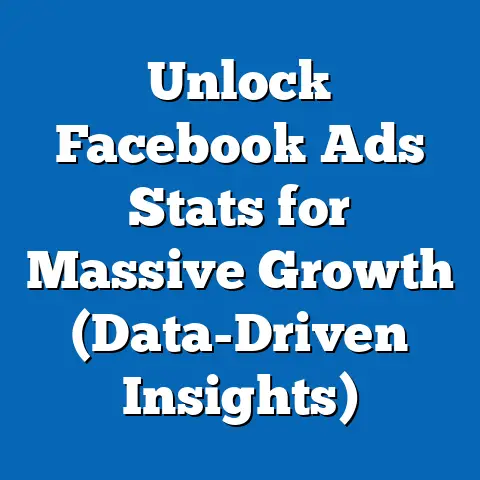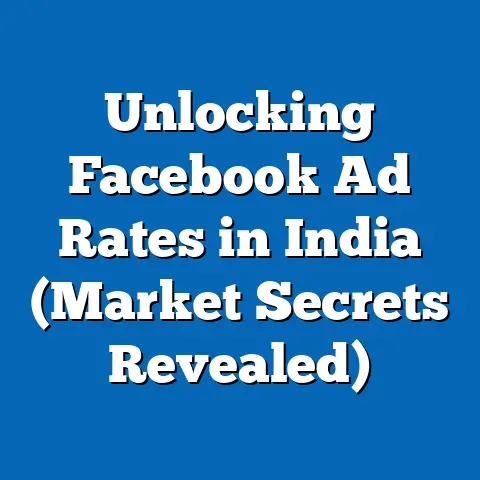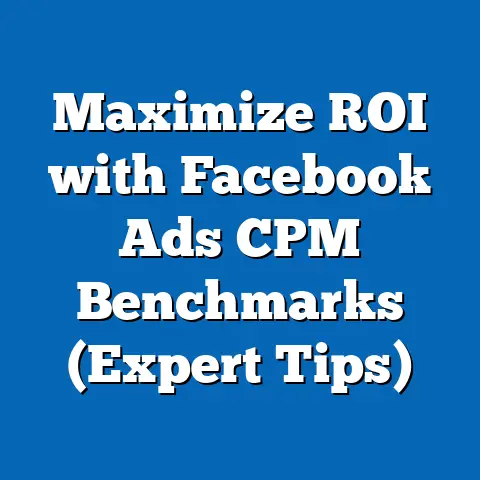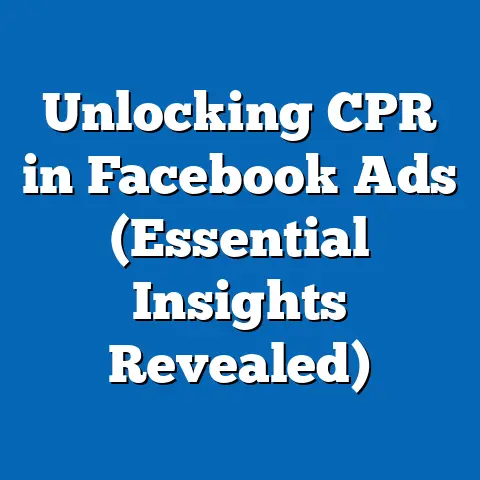Facebook Ad Set vs Campaign: What You Must Know (Key Insights)
In today’s digital marketing arena, Facebook advertising stands as a powerhouse, capable of reaching billions of potential customers worldwide. But here’s the thing: simply throwing money at Facebook ads won’t guarantee success. What truly separates the winners from the losers is a deep understanding of the platform’s advertising structure, particularly the crucial distinction between Facebook campaigns and ad sets. Trust me, after years of managing countless campaigns, I’ve seen firsthand how mastering these two components can dramatically influence your advertising ROI. In fact, according to a recent Statista report, Facebook advertising revenue reached nearly $118 billion in 2023, showcasing its continued dominance. But to capture a piece of that pie, you need to understand the engine that drives it. So, let’s dive into the world of Facebook campaigns and ad sets, unlocking the secrets to a more effective advertising strategy!
Understanding Facebook Advertising Structure
Think of Facebook advertising as a well-organized machine, designed to deliver your message to the right people at the right time. At the heart of this machine lies a three-tiered hierarchy: the Campaign, the Ad Set, and the Ad itself. Each level plays a unique role, working in harmony to achieve your desired advertising outcomes.
- Campaign: This is the top-level container, defining your overall advertising objective. Are you aiming to increase brand awareness, generate leads, or drive sales? Your campaign objective sets the stage for everything that follows.
- Ad Set: Within each campaign, you’ll find one or more ad sets. These are the targeting powerhouses, allowing you to define your audience, budget, schedule, and ad placements (where your ads will appear).
- Ad: Finally, at the bottom of the hierarchy are your individual ads – the creative content your audience sees. This includes images, videos, text, and call-to-action buttons.
This structure is crucial for managing and optimizing your ad performance. It allows you to test different audiences, budgets, and creative approaches within a single campaign, providing valuable insights into what resonates best with your target market. Imagine trying to run a business without any organizational structure – that’s what advertising on Facebook without understanding this hierarchy is like.
Takeaway: Facebook advertising is structured in a three-tiered hierarchy: Campaign, Ad Set, and Ad. Each level has a specific purpose, working together to achieve your advertising goals.
What is a Facebook Campaign?
A Facebook campaign is the foundation of your advertising efforts. It’s where you define your overarching goal – what you want to achieve with your advertising. This could be anything from increasing brand awareness and driving website traffic to generating leads and boosting sales.
Campaigns are geared towards these broad objectives, acting as the umbrella under which all your ad sets and ads operate. When creating a campaign, you’ll need to choose an objective that aligns with your business goals. Facebook offers a range of campaign objectives, including:
- Awareness: Reach people who are more likely to pay attention to your ads and increase awareness for your brand.
- Traffic: Send people to your website, app, or Facebook page.
- Engagement: Get more page likes, event responses, or post shares.
- Leads: Collect contact information from potential customers.
- App Promotion: Encourage people to install and use your app.
- Sales: Drive sales of your products or services.
Once you’ve chosen your objective, you’ll need to give your campaign a descriptive name (e.g., “Summer Sale Campaign”). This helps you stay organized, especially when managing multiple campaigns. For example, I once ran a campaign for a local bakery with the objective of driving foot traffic to their store. I named it “Bakery – Local Awareness” to easily identify its purpose and target audience.
Different types of businesses benefit from different campaign objectives. For example, a new startup might focus on brand awareness, while an e-commerce store might prioritize sales. Understanding your business goals is key to choosing the right campaign objective.
Takeaway: A Facebook campaign is the top-level structure that defines your advertising objective. Choosing the right objective is crucial for achieving your desired results.
What is a Facebook Ad Set?
An ad set is where the rubber meets the road in Facebook advertising. It’s the level where you define your target audience, set your budget, schedule your ads, and choose your ad placements. Think of it as the engine that drives your campaign, determining who sees your ads and how much you spend to reach them.
Here are the critical elements of an ad set:
- Audience Targeting: This is where you define who you want to see your ads. You can target based on demographics (age, gender, location), interests, behaviors, and connections.
- Budget: You set a daily or lifetime budget for each ad set, determining how much you’re willing to spend on reaching your target audience.
- Schedule: You can choose to run your ads continuously or set a specific start and end date.
- Placements: You select where you want your ads to appear, such as Facebook News Feed, Instagram Feed, Audience Network, or Messenger.
Audience segmentation is crucial for effective ad sets. Instead of targeting everyone, you can create different ad sets for different segments of your audience. For example, I once managed a campaign for a clothing retailer and created separate ad sets for men and women, targeting each group with relevant products and messaging.
Here are some examples of how different ad sets can be tailored to various audience segments:
- Ad Set 1: Young Adults (18-25)
- Targeting: Interests in fashion, music festivals, and social media.
- Placement: Instagram Feed and Stories.
- Budget: $20/day.
- Ad Set 2: Parents (30-45)
- Targeting: Interests in parenting, family activities, and education.
- Placement: Facebook News Feed.
- Budget: $30/day.
- Targeting: Interests in fashion, music festivals, and social media.
- Placement: Instagram Feed and Stories.
- Budget: $20/day.
- Targeting: Interests in parenting, family activities, and education.
- Placement: Facebook News Feed.
- Budget: $30/day.
By creating targeted ad sets, you can ensure that your ads are seen by the people who are most likely to be interested in your products or services, leading to higher engagement and conversions.
Takeaway: An ad set is where you define your target audience, budget, schedule, and ad placements. Effective audience segmentation is crucial for maximizing your advertising ROI.
Key Differences Between Campaigns and Ad Sets
While both campaigns and ad sets are essential components of Facebook advertising, they serve distinct purposes. Understanding their differences is crucial for creating effective and efficient advertising strategies.
Here’s a comparative analysis:
| Feature | Campaign | Ad Set |
|---|---|---|
| Purpose | Defines overall advertising objective | Defines target audience, budget, and placements |
| Focus | Objective (e.g., awareness, traffic, sales) | Targeting and budget management |
| Scope | Broad, overarching | Specific, targeted |
| Settings | Objective, naming conventions | Audience, budget, schedule, placements |
| Feature | Campaign | Ad Set |
|---|---|---|
| Purpose | Defines overall advertising objective | Defines target audience, budget, and placements |
| Focus | Objective (e.g., awareness, traffic, sales) | Targeting and budget management |
| Scope | Broad, overarching | Specific, targeted |
| Settings | Objective, naming conventions | Audience, budget, schedule, placements |
In essence, campaigns focus on the what – what you want to achieve with your advertising. Ad sets, on the other hand, focus on the how – how you’ll reach your target audience and achieve your campaign objective.
Businesses can leverage these differences to optimize their advertising strategies by:
- Testing different audiences: Create multiple ad sets within a single campaign to test different targeting options and identify the most responsive audience segments.
- Managing budgets effectively: Allocate budgets strategically across different ad sets based on their performance.
- Optimizing placements: Experiment with different ad placements to find the most effective channels for reaching your target audience.
By understanding the unique characteristics of campaigns and ad sets, you can create a more targeted and efficient advertising strategy, leading to better results and a higher ROI.
Takeaway: Campaigns define the overall objective, while ad sets focus on targeting and budget management. Leveraging these differences is key to optimizing your advertising strategy.
Best Practices for Campaigns and Ad Sets
Effectively managing and optimizing both campaigns and ad sets is crucial for achieving advertising success on Facebook. Here are some key insights and best practices to keep in mind:
- A/B Testing: Continuously test different ad creatives, targeting options, and placements within your ad sets to identify what resonates best with your audience. I once ran an A/B test on two different ad creatives for the same product and saw a 30% increase in conversions with the winning ad.
- Data Analysis: Regularly analyze your campaign and ad set performance metrics, such as reach, impressions, click-through rate (CTR), and conversion rate. Use this data to identify areas for improvement and make informed decisions about your advertising strategy.
- Budget Optimization: Adjust your budgets based on ad set performance. Allocate more budget to high-performing ad sets and reduce budget for underperforming ones.
- Targeting Refinement: Continuously refine your targeting options based on performance data. Exclude audience segments that are not responding well to your ads and focus on those that are most likely to convert.
- Placement Optimization: Experiment with different ad placements to find the most effective channels for reaching your target audience. Monitor performance metrics for each placement and adjust your strategy accordingly.
Performance metrics play a vital role in evaluating the success of your campaigns and ad sets. Key metrics to track include:
- Reach: The number of unique people who saw your ads.
- Impressions: The number of times your ads were displayed.
- Click-Through Rate (CTR): The percentage of people who clicked on your ads.
- Conversion Rate: The percentage of people who completed a desired action (e.g., made a purchase, filled out a form) after clicking on your ads.
- Cost Per Acquisition (CPA): The average cost of acquiring a customer through your advertising.
By consistently monitoring these metrics and making adjustments to your campaigns and ad sets, you can significantly improve your advertising performance and achieve your desired results.
Takeaway: Continuous A/B testing, data analysis, and budget optimization are essential for maximizing the effectiveness of your Facebook advertising campaigns and ad sets.
Conclusion
In conclusion, understanding the nuances between Facebook campaigns and ad sets is paramount for any business aiming to succeed in the competitive world of digital advertising. Campaigns set the stage by defining your overarching objectives, while ad sets act as the engines, targeting the right audience and managing your budget effectively.
By leveraging the unique characteristics of both campaigns and ad sets, businesses can create more targeted, efficient, and ultimately, more successful advertising strategies. Remember to continuously test, analyze, and optimize your campaigns and ad sets based on performance data.
As Facebook advertising continues to evolve, staying informed about the latest features, best practices, and trends is crucial. Embrace the power of data-driven decision-making and never stop experimenting to find what works best for your business. The future of Facebook advertising is bright, and with the right knowledge and strategies, you can unlock its full potential and drive significant growth for your business.
Final Thought: Facebook advertising is not just about creating pretty ads; it’s about understanding the platform’s architecture and using it strategically to reach the right people with the right message at the right time. So, go out there, experiment, and conquer the world of Facebook advertising!






